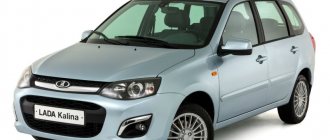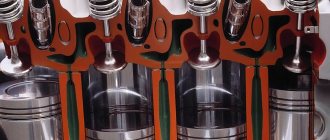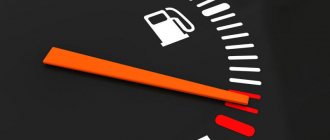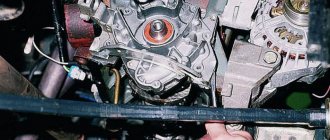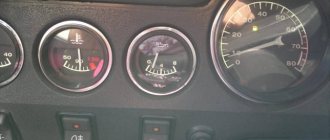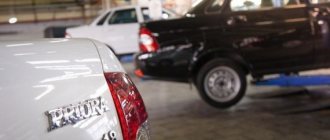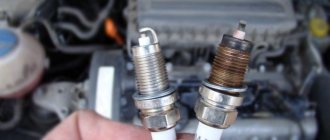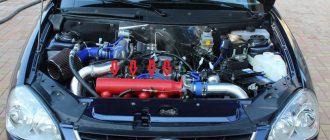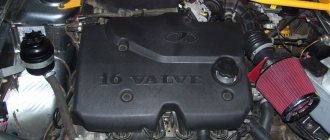From our material you will learn what to do if after an engine overhaul the oil consumption has increased, what oil to fill in after the overhaul, as well as all the nuances of this issue.
Having “overhauled” the engine, we hope to get a unit with characteristics like a new one. However, at first a number of questions arise. For example, why does the engine “eat liters of oil” after a major overhaul? The work was carried out by a professional service station, all components with the logo of the manufacturer of your car, the running-in of the diesel engine after overhaul was carried out according to the procedure. However, smoke comes out of the pipe, and you add 100-200 grams every 500 km. Is this normal? Let's figure it out.
The material was prepared by specialists from the website Skrutit-speedometr.ru.
After engine overhaul, oil consumption increased: causes and actions
From our material you will learn what to do if after an engine overhaul the oil consumption has increased, what oil to fill in after the overhaul, as well as all the nuances of this issue.
Having “overhauled” the engine, we hope to get a unit with characteristics like a new one. However, at first a number of questions arise. For example, why does the engine “eat liters of oil” after a major overhaul? The work was carried out by a professional service station, all components with the logo of the manufacturer of your car, the running-in of the diesel engine after overhaul was carried out according to the procedure. However, smoke comes out of the pipe, and you add 100-200 grams every 500 km. Is this normal? Let's figure it out.
The material was prepared by specialists from the website Skrutit-speedometr.ru.
Why, after repairing the engine, does it consume oil?
The first and main reason is the absence of a so-called “mirror” on the cylinder walls. Overhaul involves processing (and possibly boring) cylinder head liners. After which the so-called honing. Microscopic scratches are applied to the walls in a certain order. During the running-in process, these risks are polished, ensuring perfect tightness (and as a result, good compression).
However, honing is the reason why oil consumption increased after engine overhaul. Possible incorrect orientation of the rings, or other errors by repairmen. But most often the reason is in the honing. Usually after 1000-2000 km the problem disappears. If oil consumption has not decreased after engine overhaul and running-in, it is necessary to remove the cylinder head and measure the liners for geometry.
Another possibility is a problem with the valves. Valve seals and poor-quality processing of the neck can also contribute to this.
Many car owners, not understanding why the engine is burning oil after repairs, immediately try to repeat the investment. And sometimes it’s enough just to check the gaskets and seals for leaks.
What to do if oil consumption increases after an engine overhaul?
After a major overhaul, lubricant consumption may increase sharply, topping up may be required every 500 kilometers, and the smoke from the pipe will increase sharply. Why is this happening?
Firstly, because the “mirror” on the cylinder walls disappears. During overhauls, sleeves are often bored and scratches are applied to their walls. And during gradual running-in, they are polished, a surface appears - a mirror, which improves the tightness.
Applying small scratches - honing - is responsible for increased oil consumption. The second most common reasons: various errors during repairs in the service. For example, the rings are not oriented correctly. However, the most common cause is honing, so you should start sounding the alarm only if after 1000 km the problem has not improved in any way and the pipe continues to smoke. As a rule, after running in 2,000 kilometers, the problem disappears by itself. But if running in does not help, you need to remove the cylinder head and measure the liners, checking their geometry.
The third probable cause is valves. Problems with them can lead to increased oil consumption due to poor journal processing.
The main rule is not to rush your horses and not to rush to re-major disassembly of the engine before it is fully run-in. Many minor defects will be removed by themselves if used correctly. The only thing is that you need to regularly check the seals and gaskets for leaks.
Changing the oil after engine overhaul
Lubricants are changed more often than usual during break-in. And, of course, along with the filter. Metal shavings and wear debris are bound by oil and must be removed from the engine crankcase. Since repeated oil changes after engine overhaul are expensive, I want to save money on the manufacturer. You can use the recommended brands, or limit yourself to the tolerances established by the car manufacturer. The main thing is not to experiment with viscosity .
There are also special break-in oils. They contain special additives that wash out wear products and do not clog oil channels. But the repair instructions for your car prescribe certain brands of repair oils. And they must be strictly adhered to.
What kind of oil should I fill in after an engine overhaul for normal operation?
It must be remembered that upon completion of the repair, some characteristics of the power unit change. If professionals recommended using oil of a different viscosity on a worn-out engine, then the “rebuilt” engine should operate with the established parameters.
There are two opposing positions. Worn oil seals and gaskets leak liquid oil, so many services suggest increasing the viscosity. And vice versa - there is an opinion that thick lubricant does not pass through clogged oil lines. After the overhaul and completion of the break-in cycle, you need to return to the factory lubricant table for your car.
If your car has been out of production for a long time (this is a common thing in the case of major repairs), it can be difficult to find oil with the approval specified in the operating instructions. For example, Ford stops supporting cars that are more than 15 years old. In such cases, lubricants are selected only by viscosity, and professionals will help you choose a manufacturer.
Source
What kind of oil should I fill in after a major overhaul?
After repairs, the engine should be filled with the recommended brand of oil, although various special break-in aids are offered. There are two approaches to selecting the characteristics of the lubricant after the capital:
- Increase the viscosity slightly after repairs, because worn engine gaskets or seals can leak liquid oil.
- Reduce viscosity because thick grease can get stuck in clogged oil lines.
However, after 2000 kilometers of running-in, it is worth returning to the viscosity preset by the manufacturer at which the car was previously operated.
However, immediately after repairs and filling with lubricant, an emergency light may come on, indicating that the oil pressure is too low after a major overhaul. Why is this happening?
Oil starvation and blinking indicator appear due to lack of lubrication in the engine. And if there are no obvious leaks that are easy to notice in the car or even visually under it, it is worth assessing the viscosity of the liquid. If the viscosity is too low, the oil is fluid and the required pressure is not achieved. Hence the blinking of the indicator not immediately, but after the engine warms up - from the high temperature the oil becomes more liquid and fluid, again reducing the pressure.
The indicator will flash if antifreeze or antifreeze gets into the lubricant; this not only dilutes the oil, but can lead to foaming, which will enter the pump.
Everything you need to know about the causes of oil consumption and how to fix it
Typically, engine oil consumption is considered an indicator of its technical condition. Negotiations about buying a used car often begin with the question of oil consumption. In fact, increased oil consumption does not always indicate serious problems with the engine, just as the absence of this consumption cannot guarantee the ideal condition of the engine.
What is high oil consumption?
To begin with, a rhetorical question: is a liter of oil per thousand km a lot or a little? Everything is individual, for V6 or V8 engines this is almost within the norm, for in-line small cars this is definitely a lot. You must understand that any engine, even a completely new one, consumes oil. Actually, the engine oil simply burns away in the cylinders, remaining on their walls. This is the purpose of oils - to cover all internal surfaces with a film and prevent dry friction. And this film burns in the chamber along with the fuel mixture.
Question Oil consumption - what is it? only how much oil is burned in your engine and whether you need to do something about it. The experience of many owners of used cars shows that even in a fairly worn-out engine, in most cases it is more profitable to simply add oil than to do a major overhaul.
We should probably start with this. In fact, there are slightly more reasons for increased oil consumption than, in the language of service station “specialists,” simply a “dead” engine. The engine oil can burn excessively, or it can also simply leak. And diagnosing the real cause of increased oil consumption in most engines is actually quite difficult.
Why, after repairing the engine, does it consume oil?
The first and main reason is the absence of a so-called “mirror” on the cylinder walls. Overhaul involves processing (and possibly boring) cylinder head liners. After which the so-called honing. Microscopic scratches are applied to the walls in a certain order. During the running-in process, these risks are polished, ensuring perfect tightness (and as a result, good compression).
However, honing is the reason why oil consumption increased after engine overhaul. Possible incorrect orientation of the rings, or other errors by repairmen. But most often the reason is in the honing. Usually after 1000-2000 km the problem disappears. If oil consumption has not decreased after engine overhaul and running-in, it is necessary to remove the cylinder head and measure the liners for geometry.
Another possibility is a problem with the valves. Valve seals and poor-quality processing of the neck can also contribute to this.
Many car owners, not understanding why the engine is burning oil after repairs, immediately try to repeat the investment. And sometimes it’s enough just to check the gaskets and seals for leaks.
Why does it consume oil after boring the liner?
Read
Running in a diesel engine after a major overhaul requires us to take exactly the same preliminary actions. After serious intervention in the engine , it is impossible to immediately subject it to intense loads. Although such behavior will benefit service station owners.
Starting the engine after a major overhaul must be careful and can be carried out according to several schemes. The simplest scheme involves running in at idle. Its essence is that after starting, warm up the engine at idle for 5-10 minutes and turn it off, allowing it to cool. This procedure is repeated many times to check:
No leaks or pressure surges are allowed. After 4-5 repetitions, it is necessary to begin the longest part of the engine break-in - after starting, the engine must idle for at least 10 hours. During this time, the driver monitors the condition of the car and briefly increases the crankshaft speed every 15-20 minutes. And also once an hour it completely stops the engine , gives it a break, and checks the level of oil, coolant and fuel. Moreover, the temperature of the coolant all this time should be within the range of 80 degrees Celsius. After the break-in is completed, you will have to change the oil filters, oil and diagnose the valve mechanism (with an emphasis on thermal clearances).
Engine oil consumption rates according to the manual
Lada Priora is equipped with four power units of different modifications and each of them has a certain oil consumption:
- VAZ-21116 (8cl, 1.6l, 87hp) – 50 g/1000 km
- VAZ-21126 (16cl, 1.6l, 98hp) – 50 g/1000 km
- VAZ-21127 (16cl, 1.6l, 106hp) – 50 g/1000 km
- VAZ-21128 (16cl, 1.8l, 98hp) – 300 g/1000 km
As you can see, for the first three power units the consumption rate does not exceed 50 g per 1000 kilometers, and the last engine, which is a modernized version of the engine from the VAZ 21127, consumes much more.
The key feature of the 1.8-liter engine is that, while the block height remained unchanged, the piston stroke was increased due to a different crankshaft. This was realized using short connecting rods. This design solution led to increased load on the following engine elements:
In some cases, if there is excessive wear of parts of the Priora power unit, there is oil in a volume of up to 2-3 liters per 1000 kilometers.
Changing the oil after engine overhaul
Lubricants are changed more often than usual during break-in. And, of course, along with the filter. Metal shavings and wear debris are bound by oil and must be removed from the engine crankcase. Since repeated oil changes after engine overhaul are expensive, I want to save money on the manufacturer. You can use the recommended brands, or limit yourself to the tolerances established by the car manufacturer. The main thing is not to experiment with viscosity .
There are also special break-in oils. They contain special additives that wash out wear products and do not clog oil channels. But the repair instructions for your car prescribe certain brands of repair oils. And they must be strictly adhered to.
Mandatory oil changes 4 times
Be sure to use high-quality oil and change it at regular intervals up to four times. Therefore, you should prepare for the cost of oil consumption after a major overhaul.
- First replacement after 500 km running-in.
- 1000 km - second oil change along with the oil filter.
- 1500 km.
- 2 thousand km. — control oil change after major repairs.
All this time, the car should be operated in a gentle mode, for at least three thousand kilometers, and especially not increase the speed in the first thousand.
For what reasons does the engine consume oil, what to do
Almost every driver faces the problem of burning oil in the engine. This situation can be caused by many reasons. Only after diagnosing the engine can the cause of the high consumption be determined.
If the engine is new or has undergone a major overhaul, then the norm is a consumption of 20-40 grams per thousand kilometers. If the conditions in which the car is operated are difficult (mountainous terrain, sudden and frequent acceleration), then the consumption can reach 100 - 200 grams per thousand. But when oil consumption is measured in large quantities, you can be sure that something is wrong with the engine.
For what reasons does the engine eat more oil than it should?
To understand why the engine began to consume more oil, you need to study the factors leading to this situation.
Engine overheating
One of the reasons for increased engine oil consumption is too high a temperature in the cylinders. This happens when the ignition timing is broken; if we are talking about a diesel engine, then the fuel is injected at the wrong time. If you use gasoline that is not intended for a particular engine, the temperature will also become too high due to detonation.
If the engine overheats, the oil seals are damaged and scuff marks appear on the cylinder walls. Often one incident of overheating is not enough to cause damage. Of course, if this did not last long and the coolant was not brought to a boil.
Usually, even a couple of such cases pass without harm to the motor. But with several overheats, the material of the caps becomes rough. The required contact between them and the valves is not ensured. The result is that oil appears in the intake manifold. Then it enters the cylinders, and smoke can be seen in the exhaust gases.
Using oils that are not suitable for viscosity
Cuffs may lose their original properties if incorrectly selected additives are used. Oil consumption will also be increased in the case when, instead of the one provided for a particular car, the first available one is filled.
It’s good if it matches the required viscosity, or the parameters are close to it. If this is not the case, then increased consumption cannot be avoided.
Engines that were developed in the 80s were designed to operate with viscous mineral water; as a result, thinner synthetic compounds cause leaks.
Among other things, a unit designed for mineral oil begins to smoke when filled with synthetic oil. Modern engines run on synthetics, and the use of mineral compounds will lead to oil getting into the combustion chamber and repairs even after a relatively short mileage.
Wear of rings, valve stem seals
The next reason for increased oil consumption is wear of the piston rings or oil seals, or both. In such cases, the oil ends up in the combustion chamber, as evidenced by the smoke in the exhaust gases.
Why does Lada Priora “eat” oil?
Motor oil and its main functions
Main reasons for increased oil consumption
Despite the fact that the Lada Priora has an improved engine, it consumes a certain amount of engine oil. Oil consumption increases significantly if:
- there is a leak,
- parts are worn out,
- low-quality oil is used,
- oil service life has been exceeded,
- oil combustion,
- oil evaporation
The cause of oil leakage is poor crankcase ventilation. This happens when exhaust gases enter the crankcase through the joints of the piston rings. Excessive gas pressure occurs in the crankcase, which leads to the destruction of all processes in the lubrication system. The crankcase ventilation system is designed to remove these gases. After the gases are removed, the pressure returns to normal. But if the ventilation system channels are dirty, excess pressure will force the oil through the rubber seals. Therefore, it is so important to normalize the operation of the crankcase ventilation system.
The reason for wear of parts is operating the car in one mode: operating the car at high speeds for a long time. Therefore, it is recommended to switch to a lower engine speed mode, otherwise engine repair is inevitable.
Using low-quality oil. For any car, and Lada Priora is no exception, it is recommended to use the oil offered by the plant that produced the car. If you initially use synthetic oils, then it is possible to switch to another oil - semi-synthetic. Cheap mineral analogues are best used on low-speed engines, but not in Lada Priora.
The service life of the oil must not be exceeded, because This will cause the oil level to drop. During oil operation, the oil interacts with gases, fuel and rubbing parts, as a result of which it loses its properties.
Engine oil waste is the most common cause of losses.
A drop in oil level is a consequence of its evaporation process. This is caused by a change in the lubricating properties of the engine oil. Due to the fact that different brands of oils have different viscosities, they are recommended to be used under certain temperature conditions, which is also recommended by the manufacturer.
The problem of increased oil consumption can be partially solved by switching from synthetics to semi-synthetics. Semi-synthetics contain an additional number of additives and compensators, making them more practical and reliable.
Oil may burn due to worn valve caps. This problem can be diagnosed visually: blue smoke when the engine starts. In this case, the caps must be replaced. If this is not done in a timely manner, engine repair will be necessary. With a more thorough diagnosis of all Lada Priora systems, it is possible to identify the problem of why the car “eats” oil. The result could be any of the reasons discussed above. Therefore, timely elimination of the malfunction entails an extension of the engine service life. 08/02/2019
How to find the cause of oil burning
The reasons for increased oil consumption can be found independently. When you press the accelerator pedal, when the engine produces at least two thousand revolutions, smoke is present in the exhaust gases. This means that oil enters the combustion chambers after passing through bad seals.
When it comes to diesel, the appearance of gray or bluish smoke is a sign that oil is passing through the caps or between the cylinders and the cylinder walls.
More on the topic: Buy a new Eclipse Cross and don’t miss out on the benefits
If the oil is leaking thoroughly, its traces under the car become a sign of this. With weak leaks, spots appear only on the engine. Finding the exact location where the leak is is not difficult. You need to thoroughly wipe the engine, let it run for a while, and inspect everything carefully.
To check the ventilation system, remove the PVC valve and blow it out. During normal operation of the valve, air flows in one direction with little resistance. The hose and pipe are checked in the same way.
The presence of bluish smoke in the exhaust gases indicates damage to the gasket. To replace it, you need to remove the cylinder head. Damage may not be visible because it is minor. But a new gasket must be installed.
If the gasket is damaged, check the condition of the surface of the cylinder block and the plane of the head. The slightest irregularities require repairs. You can do it yourself by sanding the surface with a large emery wheel.
Beforehand, if a block is being sanded, all the holes on it are closed. After sanding the block or gasket, both should be thoroughly washed.
Reasons for high engine oil consumption
Among the main reasons why Priora consumes oil are:
- Unsuitable engine lubricant.
- Malfunction of the power unit (wear of valve stem seals, piston rings and other components).
- Aggressive driving style (high speeds, frequent and sudden acceleration, etc.).
- The rings, pistons and cylinder walls of the engine have not had time to break in after a major overhaul or the engine is still new.
Oil leakage
In some cases, the Priora eats oil, but does not smoke. The problem may not be the oil consumption, but the fact that it is leaking somewhere. Lubricant may leak from the engine in places such as:
- Valve cover gasket located on the top of the engine. If the seal is broken, oil smudges become clearly visible on the outer walls of the engine on the sides. As a rule, a lot of oil will not escape through the gasket, but it is better to restore the seal.
- Cylinder head gasket. It is also located in the upper part of the engine under the cylinder head. The gasket can be damaged in different places, causing oil leakage (symptoms are similar to those mentioned above). Also in this case, sometimes the oil goes into the cooling system if that part of the gasket that is located between the system holes and the working cylinders of the engine is broken. Externally, the engine will be dry, but the coolant will become cloudy, and the oil in the engine will begin to foam (this can be seen on the inside of the neck cap).
- Camshaft and crankshaft oil seals. Not on all engines this leak is noticeable under the hood, since all leaks form under the engine. In advanced cases, oil stains may remain on the crankcase guard or on the ground.
- Crankcase gasket. You can notice such a leak by lifting the car on a lift or driving it onto an overpass and removing the engine protection.
- Rear crankshaft oil seal. It is usually changed when the transmission is removed, otherwise you won't be able to get to it. Leaks can be detected by smudges at the bottom of the engine on the gearbox side.
- Gasket under the oil filter. This is rare, but this possibility cannot be excluded.
Increased oil consumption, how to deal with it
ATTENTION! ATTENTION! Resuming full functionality! Rules for working in high alert mode in the Russian Federation.
If your car's oil consumption does not exceed 400 g/1000 km during active driving and the car does not smoke, do not worry and do not torture yourself and the servicemen. If the consumption is really high and (or) the car smokes a lot, there are several options:
People always believe in the best and think about major engine repairs: “This can’t happen to my car!” It ran under me no. km and nothing was done to it, just changed the oil and pads. The engine couldn't die, it was Japanese after all. “So they call the service center with questions about replacing valve stem seals (cuffs).
Questions like “my engine oil is leaking somewhere” stand out. How much does your service cost to replace camshaft(s) and crankshaft oil seals?” There is a simple but effective rule here - if after parking you find a puddle of oil under your car (even a small one) - the consumption is associated with oil leakage to the outside (but not necessarily ONLY with it.), if there is no puddle - the oil leaves through the combustion chamber. is impossible to notice it with a standard dipstick
It is possible to properly change the valve stem seals (VSC) only by removing the cylinder head, because without checking the condition (repair, replacement) of the valve guides and stems, this operation is meaningless. If there is a gap between the valve and the bushing that exceeds the permissible limit, and/or there are scuffs on the valve stem, the service life of the new caps, to put it mildly, will be greatly reduced (down to zero). The appropriate diagnostics can only be carried out by dismantling the cylinder head. Let's not forget that when removing/installing the cylinder head, it is necessary to check (restore) the mating planes of the cylinder head and the cylinder block. Moreover, if the plane of the block has a large curvature, its restoration is necessary and is carried out with complete disassembly of the block. It is also highly advisable to check the cylinder head for leaks - do a pressure test.
So, we have come to the conclusion that the first step to diagnosing / eliminating increased oil consumption is to remove - diagnose - repair the cylinder head. We remove the head - and what do we see? That's right, cylinder walls. That is, we will see many other things, but when fighting oil consumption, they are the ones that interest us. There are few options here - either the walls have preserved honking over the entire surface, there are no burrs, and the geometric dimensions of the cylinders are within tolerance, or not.
If the cylinders are worn out, no half-measures such as replacing rings and (or) valve oil seals will get you off! Only a major engine overhaul
. With boring, replacing pistons, etc.
If the cylinders are in perfect condition, the question arises: what condition are the rings in? Especially oil scrapers. They can be defective only by completely disassembling the internal combustion engine. And having completely disassembled the engine, it’s already a sin, I think, not to change them, regardless of their condition. Also, with the engine disassembled, it would be stupid not to check the crankshaft for journal wear and runout. If these defects are present, the crankshaft will have to be repaired and the bearings replaced. It turns out that in this case we save (compared to a complete overhaul of the engine
) only on new pistons and work on boring the block. The plumbing work is the same as with capital work - remove, repair defects, assemble and install the engine.
Changing only the piston rings without repairing the cylinder head is monkey work.
So. Having decided to deal with increased oil consumption, the first thing you should do is answer YOURSELF a few questions:
Depending on the answers, either contact a service center or regularly add oil to the engine, which is often more economically feasible. Evaluate the possibility of changing the owner of the car. Making \"Capital Light\" in the garage is risky, this is the worst option. Original: https://wwwboards.auto.ru/mazda/461326.html
Running in the engine after overhaul - VAZ and other cars
Before you start running in, you need to perform a number of simple but necessary steps.
If you previously deviated from the advice of manufacturers and used cheaper oil , then during break-in you should return to those recommended specifically for your car brand. It is important to check that oil enters the engine components within 3-5 seconds, since “oil starvation” is unacceptable. It is important to check the oil pressure level at idle speed; it varies depending on the type of engine between 0.5 - 1.0 atm.
Source
Why is it necessary to run in an engine after a major overhaul?
Running in an internal combustion engine is necessary in several cases - after leaving the factory, after half a year of repairs, or after a long period of inactivity. Moreover, you should consider that a factory engine is always faster to run in than a repaired one. Even perfectly fitted parts cannot be so smooth that you can drive at full speed on the first trips.
Read
It is important to realize that engine overhaul involves the introduction of machined parts, which are impossible to fit together with 100% quality. Therefore, they need long-term running-in, during which the mechanism will achieve complete harmony. In general, running-in takes about 3000-5000 km in summer, and up to 6000-7000 in winter. In general, this depends on the type of repair, the fuel and lubricants used, the roads and the skill of the driver.
After a rebuild, the engine may consume oil.
Messages: 131 Registered: Jul 31, 2008, 00:00 :
Awards: 1
| Rating: 141 |
| Reputation: 0 |
Turbodiesel eats oil after capitalization
Post by S2dent » 16 Nov 2021, 03:08
Huge oil consumption after overhaul, namely 1 liter per 100 km. Given: 2.0 DW10CTED4 163hp 2014 mileage 130 thousand km. Before the overhaul, it consumed 1 liter of oil per 1000 km.
Further work: 1) Both catalysts and particulate filter were removed programmatically and physically. 2) The engine was overhauled using a liner for the old pistons, with rings being replaced and the hone being cut and the plane polished after the liner (after the sleeve the block was measured twice, everything is normal). The reason for the overhaul is a large hole in the upper part of all 4 cylinders. Before lining and again before assembly, the pistons were measured twice, no deviations were found. 3) Cylinder head repair: new seats (8 pieces per release), replacement of 16 valves, replacement of 16 guides, 16 valve stem seals, 16 hydraulic compensators, 16 rocker arms. The valves have been lapped. The cylinder head plane was in perfect order 4) Repair of the turbine, namely replacement of bearings. Otherwise, no problems were found with the turbine. The turbine was repaired in St. Petersburg. Before the overhaul, the turbine was overblown. 5) the thermostat with temperature sensor was replaced 6) the injectors were checked on a bench, no deviations were found. 7) a new oil separator was installed. During assembly, all parts were washed and cleaned. 9) The USR was not touched, just washed clean
2) The engine was overhauled using a liner for the old pistons, with rings being replaced and the hone being cut and the plane polished after the liner (after the sleeve the block was measured twice, everything is normal). The reason for the overhaul is a large hole in the upper part of all 4 cylinders. Before lining and again before assembly, the pistons were measured twice, no deviations were found. 3) Cylinder head repair: new seats (8 pieces per release), replacement of 16 valves, replacement of 16 guides, 16 valve stem seals, 16 hydraulic compensators, 16 rocker arms. The valves have been lapped. The cylinder head plane was in perfect order 4) Repair of the turbine, namely replacement of bearings. Otherwise, no problems were found with the turbine. The turbine was repaired in St. Petersburg. Before the overhaul, the turbine was overblown. 5) the thermostat with temperature sensor was replaced 6) the injectors were checked on a bench, no deviations were found. 7) a new oil separator was installed. During assembly, all parts were washed and cleaned. 9) The USR was not touched, just washed clean
Now, having driven 400 km, I added 4 liters of oil. The turbine drives oil into the intake manifold. Then they turned off the turbine and the consumption dropped to 200 g per 100 km. Large oil leaks were observed from under the covers where the injectors are located; there should be no liquids there at all. Opening the lid revealed a large amount of oil. The engine temperature does not rise above 50 degrees, the cabin is cold. There is a standard Webasto heater, but how it works and whether it works at all is not clear.

